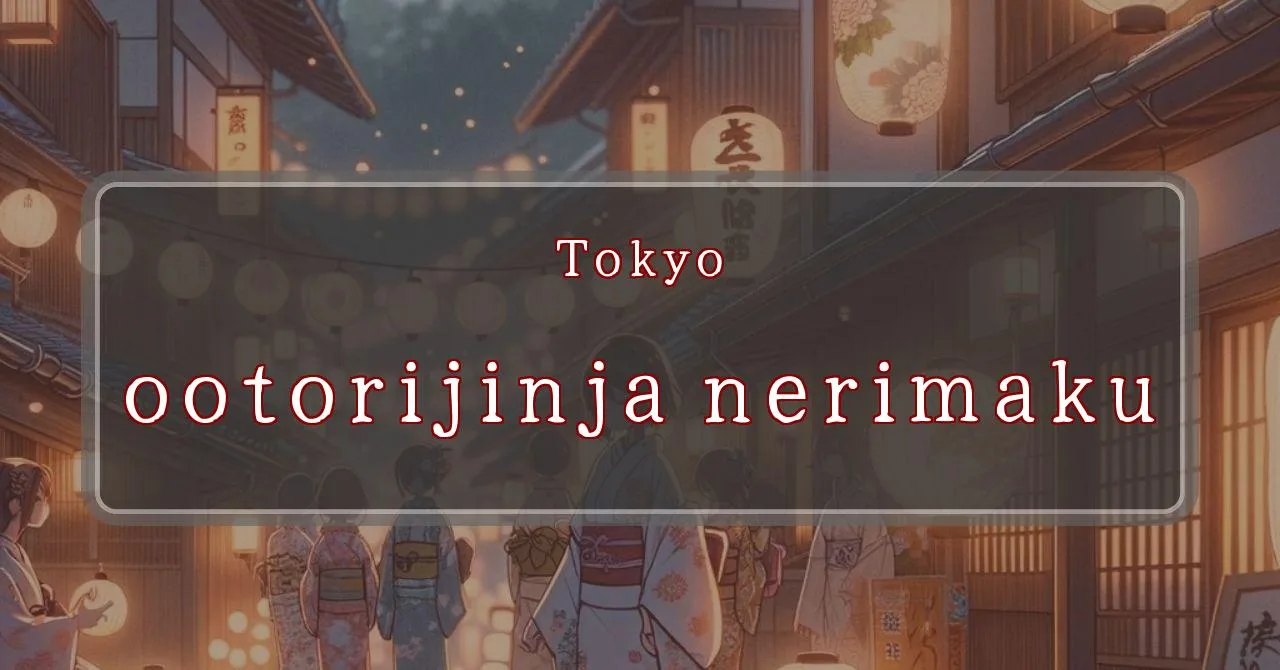Gleaming lights and joyous spirits at the Ootori Jinja Festival
Basic Information
Ootori Jinja is a Shinto shrine located in Nerima, Tokyo, Japan. It is dedicated to the deity Amaterasu Omikami, the sun goddess and the mythical ancestor of the Japanese imperial family.
- Address: 5-18-14 Toyotamakita, Nerima-ku, Tokyo 176-0012
- Phone Number: 03-3995-1600
- Access: 2-minute walk from Nerima Station on the Seibu Ikebukuro Line or Toei Oedo Line
- Festival Days: November 8th (Fri) and November 20th (Wed) in 2024
Main Events and Attractions of the Festival
The Ootori Jinja Festival is a lively and colorful event that attracts thousands of visitors each year. The main events and attractions of the festival include:
Ootori Jinja酉の市 (Tori no Ichi)
The highlight of the festival is the酉の市 (Tori no Ichi), a market where visitors can purchase縁起熊手 (engimono kumade), or “lucky rakes.” These rakes are decorated with various auspicious symbols, such as gold coins, rice bales, and Mount Fuji, and are believed to bring good luck and prosperity to their owners. The market is also lined with food stalls selling a variety of traditional Japanese treats, such as taiyaki (fish-shaped cakes filled with sweet bean paste) and yakitori (grilled chicken skewers).
Mikoshi Procession
On the second day of the festival, a mikoshi (portable shrine) procession takes place. The mikoshi is carried through the streets of Nerima by a team of young men, accompanied by music and dancing. The procession is a lively and colorful spectacle that draws large crowds of spectators.
Kagura Performance
Kagura is a traditional Japanese performing art that combines music, dance, and storytelling. During the Ootori Jinja Festival, kagura performances are held at the shrine’s main hall. These performances tell stories from Japanese mythology and are a great way to learn about Japanese culture and history.
Other Events
In addition to the main events listed above, the Ootori Jinja Festival also features a variety of other events, such as:
- Live music performances
- Dance performances
- Martial arts demonstrations
- Children’s games
- Food stalls
Blessings and Deities
Ootori Jinja is dedicated to the deity Amaterasu Omikami, the sun goddess and the mythical ancestor of the Japanese imperial family. Amaterasu Omikami is revered as the goddess of light, warmth, and life, and is believed to bring blessings of good fortune, prosperity, and happiness to her worshippers.
- Deity: Amaterasu Omikami
- Blessings: Good fortune, prosperity, happiness, light, warmth, life
Origin and History
The origins of Ootori Jinja are unclear, but it is believed to have been founded in the early 17th century. The shrine was originally located in a different part of Nerima, but was moved to its current location in 1966. Ootori Jinja has a long history of serving the local community, and is a popular destination for worshippers and visitors alike.
- Founded: Early 17th century
- Original Location: Different part of Nerima
- Current Location: 5-18-14 Toyotamakita, Nerima-ku, Tokyo 176-0012
Tips and Notes for Visitors
Here are some tips and notes for visitors to the Ootori Jinja Festival:
- Dates: November 8th (Fri) and November 20th (Wed) in 2024
- Hours: 10:00 AM to 10:00 PM
- Admission: Free
- Access: 2-minute walk from Nerima Station on the Seibu Ikebukuro Line or Toei Oedo Line
- What to Bring: Comfortable shoes, cash (for food and souvenirs), camera (optional)
- What to Expect: Crowds, music, food, games, and a lively atmosphere
Parking Information
There is no parking lot at Ootori Jinja. However, there are several coin-operated parking lots in the surrounding area. Visitors are advised to use public transportation or park their cars at a nearby parking lot and walk to the shrine.
- Parking: No on-site parking, use nearby coin-operated parking lots
- Public Transportation: 2-minute walk from Nerima Station on the Seibu Ikebukuro Line or Toei Oedo Line
Popular Stalls and Food Carts in Recent Years
| Type of Stall | Description |
|---|---|
| Takoyaki | A staple at Japanese festivals. Characterized by a crispy outside and a creamy inside. |
| Jaga Butter | A simple yet popular snack of hot potatoes lavishly topped with melted butter. |
| Baby Castella | Small castella cakes, sweet and fluffy treats enjoyed by children and adults alike. |
| Grilled Ayu with Salt | Fresh ayu fish grilled whole with salt, a savory taste of Japanese summer. |
| Shaapin | A unique gourmet item influenced by foreign cuisine, with a chewy skin wrapping the filling. |
| Okonomiyaki | A Japanese grilled dish where you often choose your own ingredients for a personalized flavor. |
| Cotton Candy | A fluffy, sweet snack that’s extremely popular with children. |
| Chocolate Banana | A banana coated in chocolate, a fun and visually appealing dessert. |
| Kushiyaki | Various types of ingredients skewered and grilled, an easy-to-enjoy snack. |
| Yakisoba | Fried noodles mixed with a special sauce, a fast food favorite in Japan. |



